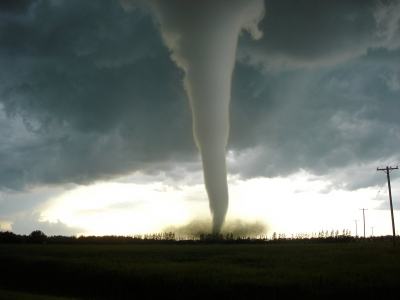The tornado outbreak of April 2, 2006 was a series of tornadoes that occurred during the late afternoon and evening of April 2, 2006, in the central United States. It was the second major outbreak of 2006, in the same area that suffered considerable destruction in a previous outbreak on March 11 and March 12, as well as an outbreak on November 15, 2005. The most notable tornadoes of the outbreak struck northeastern Arkansas, the Missouri Bootheel, and West Tennessee, where several communities including Marmaduke, Arkansas, Caruthersville, Missouri, and Newbern, Tennessee suffered devastating damage. In total, 66 tornadoes touched down across seven states, which is the most in a single day in 2006. In addition, there were over 850 total severe weather reports, including many reports of straight-line winds exceeding hurricane force and hail as large as softballs, which caused significant additional damage in a nine-state region.The outbreak was a deadly one; there were a total of 28 tornado-related deaths plus two other deaths from straight-line winds. It was the deadliest tornado outbreak in the United States since the May 2003 tornado outbreak sequence in the first week of May 2003, which killed 48 people. Twenty-six of those deaths were caused by a single supercell thunderstorm which produced damaging and long lived tornadoes from north central Arkansas into northwest Tennessee.
A tornado is a violently rotating column of air that is in contact with both the surface of the Earth and a cumulonimbus cloud or, in rare cases, the base of a cumulus cloud. It is often referred to as a twister, whirlwind or cyclone, although the word cyclone is used in meteorology to name a weather system with a low-pressure area in the center around which, from an observer looking down toward the surface of the earth, winds blow counterclockwise in the Northern Hemisphere and clockwise in the Southern. Tornadoes come in many shapes and sizes, and they are often visible in the form of a condensation funnel originating from the base of a cumulonimbus cloud, with a cloud of rotating debris and dust beneath it. Most tornadoes have wind speeds less than 110 miles per hour (180 km/h), are about 250 feet (80 m) across, and travel a few miles (several kilometers) before dissipating. The most extreme tornadoes can attain wind speeds of more than 300 miles per hour (480 km/h), are more than two miles (3 km) in diameter, and stay on the ground for dozens of miles (more than 100 km).Various types of tornadoes include the multiple vortex tornado, landspout, and waterspout. Waterspouts are characterized by a spiraling funnel-shaped wind current, connecting to a large cumulus or cumulonimbus cloud. They are generally classified as non-supercellular tornadoes that develop over bodies of water, but there is disagreement over whether to classify them as true tornadoes. These spiraling columns of air frequently develop in tropical areas close to the equator and are less common at high latitudes. Other tornado-like phenomena that exist in nature include the gustnado, dust devil, fire whirl, and steam devil.
Tornadoes occur most frequently in North America (particularly in central and southeastern regions of the United States colloquially known as tornado alley; the US and Canada have by far the most tornadoes of any countries in the world). Tornados also occur in South Africa, much of Europe (except Spain, most of the Alps, Balkans, and northern Scandinavia), western and eastern Australia, New Zealand, Bangladesh and adjacent eastern India, Japan, Philippines, and southeastern South America (Uruguay and Argentina). Tornadoes can be detected before or as they occur through the use of pulse-Doppler radar by recognizing patterns in velocity and reflectivity data, such as hook echoes or debris balls, as well as through the efforts of storm spotters.

2006Apr, 2
Over 60 tornadoes break out in the United States; Tennessee is hardest hit with 29 people killed.
Choose Another Date
Events on 2006
- 4Jan
Ariel Sharon
Prime Minister Ariel Sharon of Israel suffers a second, apparently more serious stroke. His authority is transferred to acting Prime Minister Ehud Olmert. - 21Mar
Twitter
The social media site Twitter is founded. - 11Apr
Mahmoud Ahmadinejad
Iranian president Mahmoud Ahmadinejad announces Iran's claim to have successfully enriched uranium. - 5Jun
State Union of Serbia and Montenegro
Serbia declares independence from the State Union of Serbia and Montenegro. - 29Jun
Guantanamo Bay detention camp
Hamdan v. Rumsfeld: The U.S. Supreme Court rules that President George W. Bush's plan to try Guantanamo Bay detainees in military tribunals violates U.S. and international law.

 English
English  español
español  français
français  português
português  русский
русский  العربية
العربية  简体中文
简体中文 